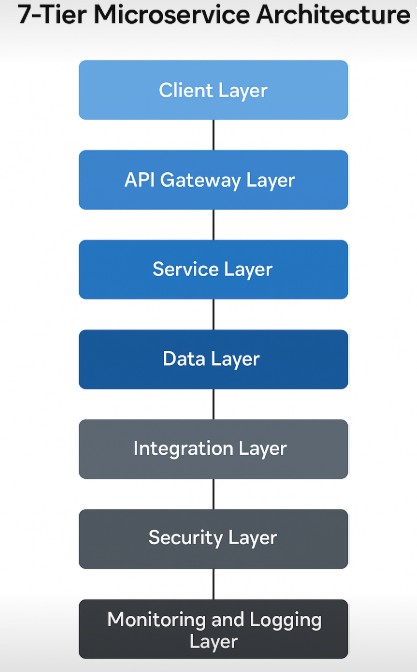7-Tier Microservice Architecture: A Comprehensive Guide (2025)

The 7-tier microservice architecture is a modern approach to building scalable, maintainable, and resilient distributed systems. This comprehensive guide explores each tier with practical examples and real-world applications.
Table of Contents
Introduction to 7-Tier Architecture
The 7-tier microservice architecture is a modern approach to building distributed systems that provides better separation of concerns, scalability, and maintainability. These tiers are:
- Presentation Tier
- Application Tier
- Business Tier
- Integration Tier
- Data Access Tier
- Infrastructure Tier
- Cross-Cutting Concerns Tier
This architecture pattern helps in building robust, scalable, and maintainable microservices by providing clear boundaries between different concerns and responsibilities.
Presentation Tier
The presentation tier is responsible for handling user interactions and presenting data. Key responsibilities include:
- User interface rendering
- Input validation
- Request routing
- Response formatting
- Error handling
Example Implementation
@RestController
@RequestMapping("/api/v1/products")
public class ProductController {
private final ProductService productService;
@GetMapping("/{id}")
public ResponseEntity getProduct(@PathVariable Long id) {
return ResponseEntity.ok(productService.getProduct(id));
}
@PostMapping
public ResponseEntity createProduct(@RequestBody ProductDTO product) {
return ResponseEntity.created(URI.create("/api/v1/products"))
.body(productService.createProduct(product));
}
}
Application Tier
The application tier serves as the orchestrator of business processes. It:
- Coordinates between different services
- Manages transactions
- Handles business process flow
- Implements use cases
- Manages service composition
Example Implementation
@Service
public class OrderProcessingService {
private final InventoryService inventoryService;
private final PaymentService paymentService;
private final ShippingService shippingService;
@Transactional
public Order processOrder(OrderRequest request) {
// Check inventory
inventoryService.reserveItems(request.getItems());
// Process payment
paymentService.processPayment(request.getPayment());
// Initiate shipping
shippingService.scheduleDelivery(request.getShippingAddress());
return createOrder(request);
}
}
Business Tier
The business tier contains the core business logic and rules. It focuses on:
- Business rules implementation
- Domain model management
- Business process logic
- Validation rules
- Business state management
Example Implementation
public class Order {
private List items;
private Customer customer;
private OrderStatus status;
public void addItem(Product product, int quantity) {
if (status != OrderStatus.DRAFT) {
throw new IllegalStateException("Cannot add items to a non-draft order");
}
items.add(new OrderItem(product, quantity));
}
public void calculateTotal() {
return items.stream()
.mapToDouble(item -> item.getPrice() * item.getQuantity())
.sum();
}
}
Integration Tier
The integration tier manages communication with external systems and services. It handles:
- External API calls
- Service-to-service communication
- Message queue integration
- Event handling
- API versioning
Example Implementation
@Service
public class PaymentGatewayIntegration {
private final RestTemplate restTemplate;
public PaymentResponse processPayment(PaymentRequest request) {
HttpHeaders headers = new HttpHeaders();
headers.setBearerAuth(getApiKey());
HttpEntity entity = new HttpEntity<>(request, headers);
return restTemplate.exchange(
"https://api.payment-gateway.com/v1/payments",
HttpMethod.POST,
entity,
PaymentResponse.class
).getBody();
}
}
Data Access Tier
The data access tier manages all data persistence operations. It provides:
- Database operations
- Data mapping
- Query optimization
- Transaction management
- Data caching
Example Implementation
@Repository
public class ProductRepository {
private final JdbcTemplate jdbcTemplate;
public Product findById(Long id) {
return jdbcTemplate.queryForObject(
"SELECT * FROM products WHERE id = ?",
new ProductRowMapper(),
id
);
}
public void save(Product product) {
jdbcTemplate.update(
"INSERT INTO products (name, price, description) VALUES (?, ?, ?)",
product.getName(),
product.getPrice(),
product.getDescription()
);
}
}
Infrastructure Tier
The infrastructure tier provides technical capabilities and platform services. It includes:
- Configuration management
- Logging and monitoring
- Security services
- Service discovery
- Load balancing
Example Implementation
@Service
public class ServiceDiscovery {
private final DiscoveryClient discoveryClient;
public List getInstances(String serviceName) {
return discoveryClient.getInstances(serviceName);
}
public ServiceInstance getInstance(String serviceName) {
List instances = getInstances(serviceName);
return instances.get(new Random().nextInt(instances.size()));
}
}
Cross-Cutting Concerns Tier
The cross-cutting concerns tier handles aspects that affect multiple tiers. It manages:
- Logging
- Security
- Transaction management
- Caching
- Error handling
Example Implementation
@Aspect
@Component
public class LoggingAspect {
private final Logger logger = LoggerFactory.getLogger(this.getClass());
@Around("@annotation(Loggable)")
public Object logExecutionTime(ProceedingJoinPoint joinPoint) throws Throwable {
long start = System.currentTimeMillis();
Object result = joinPoint.proceed();
long executionTime = System.currentTimeMillis() - start;
logger.info("{} executed in {}ms",
joinPoint.getSignature(),
executionTime);
return result;
}
}
Best Practices and Implementation
Implementing the 7-tier architecture effectively requires careful consideration of several factors:
Implementation Guidelines
- Start with a clear understanding of the domain
- Define clear boundaries between tiers
- Use appropriate design patterns
- Implement proper error handling
- Consider scalability requirements
- Plan for monitoring and observability
- Design for resilience
Common Pitfalls to Avoid
- Over-engineering the solution
- Creating too many layers
- Ignoring performance implications
- Poor error handling
- Inadequate monitoring
Conclusion
The 7-tier microservice architecture provides a robust framework for building scalable, maintainable, and resilient distributed systems. By following this architecture pattern and implementing the best practices discussed, you can create microservices that are easier to develop, test, deploy, and maintain.